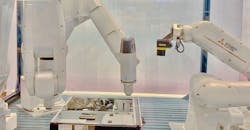The process of bringing collaborative capabilities to industrial robots first began appearing on the automation scene about three years ago when we saw some of the first demonstrations of Realtime Robotics technology at the SPS event in Nuremberg, Germany, and Veo Robotics’ technology at TechCrunch in Berkeley, Calif.
At IMTS 2022, we saw an update from Realtime Robotics that highlights work the company is doing with Mitsubishi Electric and Kawasaki Robotics (see embedded video below).
Alejandro Suarez with Realtime Robotics explained how Realtime Robotics’ RapidPlan Create and RapidPlan Realtime software are used to control Mitsubishi’s Assista cobot and RV-7FRL and RV-8CRL industrial robots in a complex path screw-driving assembly operation.
Users only have to program the robots to place the screws where needed, Suarez said. From there, the Realtime Robotics software will compute the best path possible for the robots and avoid any collisions that could occur as the three robots work together in a small space.
“If you need to make a change, you change the targets for the robots, but the motion planning is taken care of by the Realtime Robotics technology,” he said.
In another demonstration at IMTS, Tom Munger with Realtime Robotics explained how the company’s technology can be used to control robot paths in automotive spot-welding applications. In this exhibit, two Kawasaki Robotics’ BX100N robots were outfitted with ARO spot weld guns.
The spot-welding demo uses Kawasaki Robotics’ open programming platform, KRNX, along with Realtime Robotics’ motion planning and collision avoidance software. KRNX is an application programming interface plugin for real-time control of complex and irregular robot applications. Kawasaki said KRNX enables Kawasaki robots to “leverage unlimited external computing power, enabling [use of technologies such as] artificial intelligence and machine learning applications to advanced safety.”
Munger pointed out how closely the robots can operate next to each other without colliding. “They're able to operate in extremely dense configurations with our RapidPlan software used to configure and create all the motion planning that exists inside the work zone,” he said. “With RapidPlan, it's not just one single motion that exists for each robot, we’re actually pre-calculating and pre-computing thousands of motions that each one of those robots can use dynamically.”
Realtime Robotics and Kawasaki announced their partnership earlier this year, and have since partnered on several projects, including helping a large automotive manufacturer improve the speed of robot programming by 70%.
Leaders relevant to this article:



